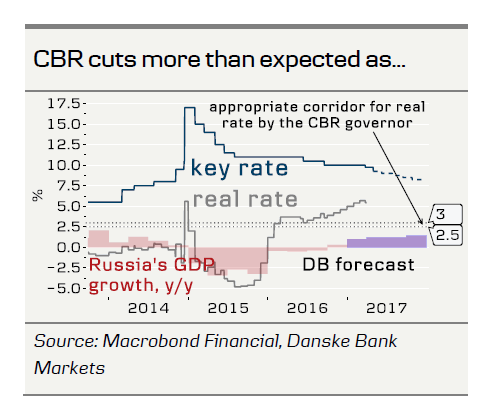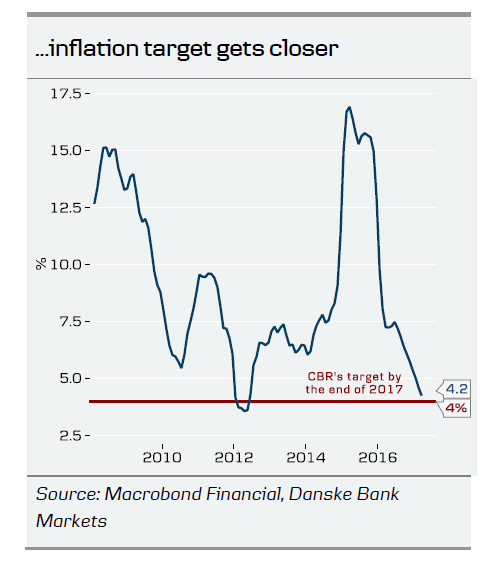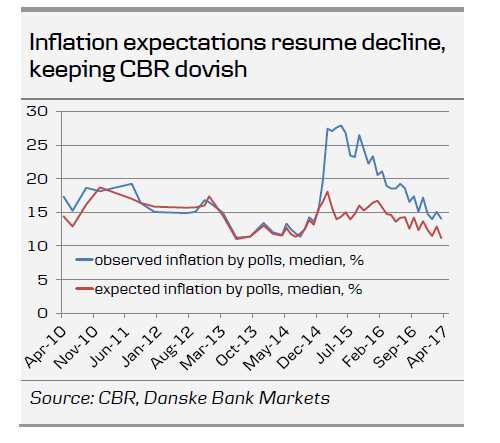- Surprisingly, Russia’s central bank (CBR) cut its key rate by 50bp to 9.25% on 28 April, as inflation is approaching its target faster than expected and RUB’s excessive rally is a concern for economic authorities.
- We expect the CBR to cut to 8.00% by the end of 2017 (8.50% previously), while more aggressive cuts are possible if RUB’s rally diverges further from the oil price.
- Aggressive monetary easing would add steam to economic growth in Russia, while the CBR’s consistency in communication could be jeopardised
Assessment and outlook
The CBR cut its key rate by 50bp to 9.25% on 28 April. Consensus expected a 25bp cut as did we. However, in our preview prior to the decision, we did not exclude a 50bp cut to restrain the RUB’s excessive strengthening. CBR governor Elvira Nabiullina signalled last week that rate cuts of 25bp and 50bp may be discussed at the meeting as inflation hit 4.1% y/y as of 17 April. While inflation is getting closer to the target (i.e. 4% y/y by the end of 2017) and inflation expectations are decreasing, in its newest statement the CBR pointed out that ‘at the same time, inflation risks remain in place’.
We see that the current aggressive cut was fuelled by concerns of economic authorities that RUB has become overvalued given the crude price levels. Previously, neither the Ministry of Finance’s (Minfin) nor the Ministry for Economic Development succeeded in convincing the markets with their vocal interventions. On Tuesday 25 April 2017, President Vladimir Putin made a RUB comment to the effect that the government is looking for ‘market-based measures’ to affect the RUB, monitoring what he called the ‘key’ issue of its stability ‘practically on a daily basis’. Actually, Putin did not take any view on RUB’s direction at all, it was purely the market’s interpretation.
Given CBR’s dovish tone and the fact that CBR’s ‘assessment of the overall potential of the key rate reduction before the end of 2017 is unchanged’, we reduce our key rate projection for the end of 2017 to 8.00% from 8.50% previously. More aggressive monetary easing on rising crude price and RUB’s excessive appreciation would encourage fixed investment expansion and private consumers supporting economic growth. We continue to see GDP growing 1.2% y/y in 2017 and 1.4% y/y in 2018.


The main reasons behind today’s decision and the CBR’s tone
‘Annual inflation has moved close to the target level.’ Annual inflation is hovering around 4.2% as steady oil and strong demand for RUB support disinflation. The CBR mentions ‘persistent interest in investment in Russian assets among external investors, and a drop in the sovereign risk premium’. The inflation target looks very realistic and the next question on the agenda will be how well the target could be anchored
‘Positive real interest rates are held at the level which ensures demand for loans without increasing inflationary pressure’. The assumption stayed unchanged since the last decision in December 2016, and the CBR did not mention Minfin’s FX operations mechanism impact this time.
The CBR saw economic expansion in Q1 17. Many industrial sectors in Russia continue to see positive dynamics, while manufacturing and services PMIs were at their three-year highs in early 2017. The CBR has become more positive on economic growth in 2017-19 ‘even if the conservative oil price scenario materialises’. In March 2017 in its monetary policy report, the CBR mentioned that its ‘conservative approach suggests a decreasing trend in the Urals price close to USD40/bbl by the end of 2017. CBR’s ‘risky’ scenario sees the oil price dropping to USD25/bbl by the end of 2017. Our models show that in current conditions, an average annual oil price lower than USD47/bbl would send Russia’s GDP into negative territory.
Inflation risks would come from oil price fluctuations caused ‘by negotiations between oil exporting countries to extend agreements on limiting oil production.’ The CBR highlights the importance of ‘legislative consolidation of a budget rule’ in mitigating medium-term inflation risks.
This time, the CBR has not mentioned risks it has linked previously to greater-thanexpected rate hikes by the Fed on the back of President Donald Trump’s potentially expansive fiscal policy, nor a slowdown in China’s economy towards end-2017.
We expect the CBR to cut the key rate by 25bp at its monetary policy meeting on 16 June 2017.

The RUB welcomes aggressive cut
First, the RUB reacted negatively to the CBR’s 50bp cut, restarting an even stronger rally as demand for local bonds – OFZs – surged. It has been a tradition for the RUB market: as the economy has turned sluggish and real rates remain high, monetary easing has been interpreted as a ‘buy’ signal for a range of Russian assets on improving economic prospects as fixed investments and household lending are set to expand..
We keep our moderately bullish stance on the RUB based on our latest FX forecast update released in mid-April. See FX Forecast Update: Political risks in charge, 18 April 2017. We still expect the USD/RUB to hit 54.40 in 3M, 53.00 in 6M and 52.00 in 12M on a Brent crude price assumption of USD58/bl in Q4 17.
We remain bullish on OFZs, as surprisingly aggressive cuts to the key rate should not be excluded if the RUB rally seizes RUB’s and oil correlation further.












